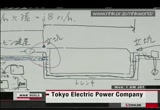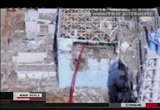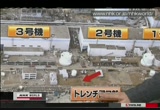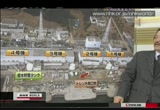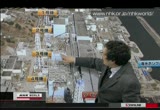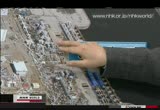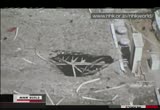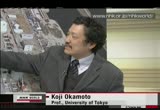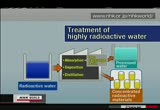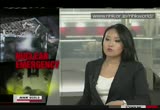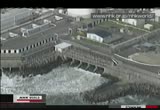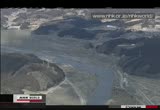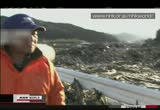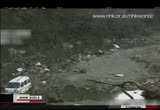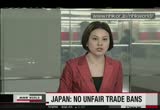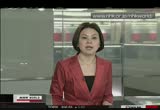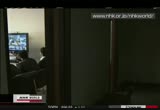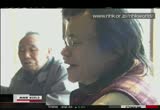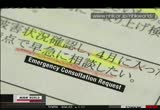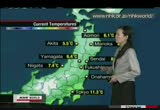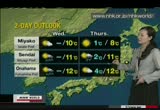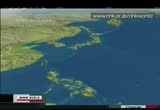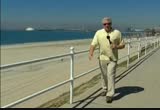tv Satellite News From Taiwan PBS March 29, 2011 7:00pm-7:30pm PDT
7:00 pm
7:01 pm
tokyo electric power company believes it's highly likely that water in the turbine building and an underground turnl near the number 2 reactor has come from the same source. earlier the independent nuclear commission says partially melted nuclear fuel is the source. tepco says water found in the underground turnl near the number 1 reactor may have been from tsunami waves. >> translator: we think water in the tunnel is not mixing with water in the number 1 reactor turbine building. >> the company says if the water in the number 1 reactor's tunnel is safe after analysis, they will consider releasing it into the sea. tepco is studying where to store the polluted water and how to remove the radioactive substances, but the company is not sure if conventional methods can effectively treat the highly
7:02 pm
contaminated water. nhk has obtained high resolution photographs of fukushima daiichi plant. they were taken an unmanned plane on march 20th and 24th, and they show the devastation caused by the tsunami and hydrogen explosions. the photos were taken by an aerial survey firm for the plant's operator, tokyo electric power company. the photo taken near the number 4 reactor shows that pump trucks connected by hoses in a line that stretches from the pier to the first four reactors. a professor at university of tokyo graduate school has studied the photos and explained what we can learn from them. >> translator: we brought some of those photographs. these are the photos taken on the 20th. what can you interpret from this? you can see the four reactors from 1 to 4, and it's a very
7:03 pm
clear photograph. we can observe how severely damaged they are. >> the number 2 reactor, 1, 2, 3 are all the same, but we keep up hearing the term "trench." where is the trench? >> yes, there is a pit connected with a trench, and usually it is covered with a building but this swept with the wave. >> this hole we see here? >> yes. this is the opening of the trench. probably these square holes are the opening of the trench. >> there's the building here and there's the turbine building and there is a trench and this is the sea? >> that's right. >> the opening of the trench is very near the sea? >> yes, from here this is the turbine building of the number 2 reactor, number 1 reactor, and
7:04 pm
so the underneath this is extended horizontally. the altitude is minus 15 meters or 20 meters, so it is very deep. so there is the vertical shaft called the pit. >> known as a lid on this hole? >> probably. the building or hut covering it was swept away. >> and it's filled with quite a lot of water? >> that's right. so there is -- the water level of the trench in the number 2 reactor is about 1 meter below the top. probably this contaminated water comes from the number 2 reactor and it's contaminated. we have to avoid that it will be released in the sea. >> the highly radioactive water, first we have to recover it and
7:05 pm
that will be used for this purpose? >> you can see this white tank there. there are three white tanks. >> this is a fire engine, yes, and this tank appears to be very big. >> well, yeah, it can contain the order amounting to 2,000 tons, and these tanks have not been damaged by the tsunami. so highly contaminated water can be collected into this -- these white tanks after it is pumping to the condenser. >> they're already filled with water? >> yes. because of that, we would like to use this first tank. it's a huge tank. so the water will be transferred from the condenser to the surge tank.
7:06 pm
>> there's quite a bit of distance here. you have to carry the water over this distance? >> you can see a number of fire trucks, and by using these -- the pumper trucks, they're going to transfer the contaminated water. >> we have another photograph. this was taken on the 24th. the number 4 is in the front. it's from a different angle. >> you can see the sea on the right-hand side. >> this is the south end? >> and you can see the number 1, number 2, number 3, number 4 reactors in this order. >> putting aside the water's already leaked, let's take a look at the number 4 reactor. >> so this is the high-power pumper truck, and the arm is extended to the fourth floor. >> very long arm. >> that's right. so here is the spent fuel pool,
7:07 pm
and i think that this is a crane to replace fuel. so the water was directly sprayed onto this part. >> and it said that the crane may have fallen, but we see it there. >> well, it's difficult to see this, but this crane to replace fuel did not drop. and the crane is usually installed on the ceiling, and so we are not sure what happened to them. >> the spent fuel is pooled under here? >> so there is the fuel about 12 meters below. >> well, there is no fuel inside the reactor for the number 4, but you have to constantly circulate the water. you say that there's one thing that concerns you about this photograph. >> so we have to circulate water, but with this pump the
7:08 pm
people are spraying water on the number 4 reactor. >> on the seaside? >> yes. especially i was very surprised of this photograph, because there is the seawater pump or pumper. and so it doesn't mean that we feed water directly from this pumper. >> so in order to remove the heat from the water, you use the seawater here? >> you can see there are three tanks, and they were knocked down by the tsunami. this is about the number 3 reactor, and this is the number 4 reactor. the facilities were lost, and probably this facility was devastated. ij that these facilities will not be restored in an easy way.
7:09 pm
>> in case of the number 4 reactor, the operation was not taking place, and so i think that the cooling it might be possible. >> looking at the number three, look at the debris, how it's scattered around. >> yes. the photographs taken by self-defense forces focused on this area and the debris is blown off. it fell on the turbine building, and i think that this is about the air pipes. >> what we see here is the turbine building roof. >> and this is a roof of the turbine building, and you can see the huge block of stone on this roof. you can see that huge pieces of debris were blown off. >> so looking at this and
7:10 pm
looking at the extent of damage and the fact that water is leaking and also the fact that you have to restore power by removing this water, it seems that it will be a major challenge. >> yes. it's very, very difficult obstacle that we have to overcome. maybe accept by step. so for number 1, number 2, and number 3 reactors, you have to continue spraying water. they need it for sure. if we continue water-spraying operation and then the water will come out. now the water level in the trench is 1 meter below the top, so we have to take proper measures to stop it from leaking out of the pit. >> what measures can you think
7:11 pm
of? >> for instance, maybe the outlet of the trench pit should be covered by something. covered by something to stop the water leakage. and then maybe we can take some time and take some more measures. at the same time there is highly contaminated water, and water purification may be possible. >> you cannot store the water, therefore, you have to purify the water and drain it? >> that's right. so here is contaminated water, and then they end up using the resins and we can purify it. this is seawater, so according to the results of some experiments, we can add some of the cesium, if it is contained in the seawater. so we can treat contaminated
7:12 pm
water as much as possible. we can release it into the sea, but if we still have some concern about the contamination level, then we can return it it the to the reactors. we can reuse the water, so maybe the total volume of cooling water will stay the same. >> but it does seem that it will take time. >> that's right. >> that was the professor at university of tokyo graduate school who studied the photos and explained what we could learn from them. france says it will send three more nuclear experts to japan to help remove highly radioactive water from the troubled power plant. two other french experts are already in japan and are holding talks with the plant operator, tokyo electric power company. the five are from french-based
7:13 pm
ariva, one of the biggest nuclear energy firms. they will help to remove the polluted water that is hampering efforts to restore the cooling functions. this is the second time that france has dispatched experts to japan since the fukushima reactors were damaged by the march 11th quake and tsunami. france has already supplied radiation measuring vehicles and protective clothing. french president nicolas sarkozy will visit japan on thursday. he will meet prime minister naoto kan about further assistance to resolve the nuclear crisis. the science ministry says levels of radiation near the fukushima daiichi plant in the seawater are higher than normal but on the decline. they have been collecting seawater samples since march 23rd. it began the research after a high-density of radioactive
7:14 pm
substances was detected in seawater near the plant's drain outlets. the ministry says 1.5 to 3.5 becquerels of radioactivity were found in seawater samples taken at four locations on sunday. the amounts are 1,000 to 2,600 times higher than those measured in the same area two years ago. the current level are only one-fifth to one-tenth of those dee detected on march 23rd. the density of iodine 131 is decreasing. it stands 159 be becquerels per liter. cesium is not absorbed into fish through gills, but some species accumulate the element by eating plankton and smaller fish. they say radioactive substances are eliminated from fish in several weeks. the march 11th quake caused
7:15 pm
extensive damage inland as well as coast al cities. we have a report. >> translator: this is ta mountain community four kilometers away from the sea. in this district the tsunami killed 40 people and many are still missing. the tsunami was caused by a river which runs in the outskirts of the town. this tsunami that washed away along the coast, backwashed up the river and climbed over the embankment and seized a residential area in the mountains. this woman saw something like smoke ridsing from between the buildings, something moving. she said she had no idea that a tsunami was approaching. this woman says that when she looked in at that direction,ge . she didn't think it was water
7:16 pm
coming. she thought it was a pile of trash coming her way. she says it was just faterrifyi. >> the community league head. after the earthquake winter to the river to close the floodgates and he noticed before anyone else the backward flow of tsunami. elsd he saw the water coming, and called on everyone to escape. but this district was not part of the anticipated tsunami damage area designated by the iwate prefecture government, therefore many people were washed away by the water without noticing a tsunami was coming. people felt secure because they never imagined that a tsunami would come up the mountains. he says he was one of them. the tsunami backwashed up the river. tsunami experts came to this
7:17 pm
town to investigate what had happened. they expected places where debris had been washed ashore, and they found that a tsunami had hit an area four meters up the motor of the river, and that tsunami maintained its momentum and flow up the river 8 kilometers upstream carrying debris and causing damage. how did the tsunami come this far? experts say that a 10-meter tsunami rushed up a river that was flowing in a straight line and did not lose momentum as it climbed up the mountain. they point out that tsunami measures are required at inlet areas also. >> in a tsunami this large it's very difficult to prevent damage, and even in the inland
7:18 pm
areas the tsunami will attack. therefore, people npt inland areas also have to plan evacuation routes and be prepared for such disaster. >> and now we take a look at lathe latest in business news. >> welcome to "newsline business." japan has asked trade partners not to impose any unfair import bans on farm produce due to radiation concerns. japanese delegates made the call ant informal meeting of the trade negotiation committee of the world trade organization on tuesday. the delegation told wto members that the japanese government is taking necessary measures, such as shipment bans on agricultural and dairy products with radioactive levels above recommended limits.
7:19 pm
the officials stress countries should not place unfair import restriction on japanese goods without any scientific basis and vowed to provide necessary information on products under question. an increasing number of countries including the united states and singapore have suspended imports of some japanese products. it comes after radiation in several farm products from prefectures near the damaged nuclear power plant were above levels recommended by japanese authorities. they will certify safety of food exports to the european union in response to the group's request to ban all imports in to northern and central japan unless accompanied by a safety guarantee. following the announcement the agriculture ministry to test food products and issue safety
7:20 pm
certificate fs the results clear eu standards. for disaster-hit areas they may handle the process on their behalf. it totaled $300 million in 2009, accounting for about 5% of all exports. tokyo stocks are moving in a narrow range on wednesday morning. the nikkei ended the morning session at 9,575, up over 100 points at 1.2%. trading is thin as investors are holds back from taking on aggressive positions. they are worried that the recent natural disaster and ongoing nuclear crisis will have a lasting impact on the economy. on the tokyo foreign exchange, the dollar is gaining ground against the yen. the greenback is trading between 82.77 to 82. the euro stands between 116.57
7:21 pm
to 62. sources say that investors are buying the dollar on growing speculation that a second round of so-called quantitative easing in which the u.s. government buying treasury securities will end early. now let's take a look at the latest long-term interest rates. this is the yield on the benchmark ten-year japanese government bond. in other asian markets, hong kong's hsi is traded over 1% higher. shanghai's key index for major blue chicaps is almost here and the sse composite is down over one-half of a percent. toho bank is the largest regional bank in fukushima prefecture, and it's making efforts to help people rebuild their lives and businesses after recent natural disaster struck the area. >> reporter: this bank is
7:22 pm
headquartered in fukushima city. by setting up temporary call centers, it's providing consultation services for account holders. >> translator: you don't have your bankbook, family seal or t atm card? >> reporter: to assist clients, they're clabting with 12 additional financial institutions. depositors can withdraw money from the accounts without the usual documentation as long as there's a way to confirm their identities. but the bank has been lagging behind in supporting regional businesses' efforts to rebuilt. since the quake the bank's task force is holding daily videoconferences with its branches in disaster-stricken areas. the goal is to thoroughly under clients' needs. >> the main production line has stopped because the boiler isn't running. >> wee received requests for factory relocation assistance and help with employee
7:23 pm
dormitories. >> they're in tough spot. many firms can't distribute their products until they've been tested for radiation. >> reporter: representatives of the bang have started to visit clients as of last week since gasoline is mother available. a hot spring resort has been hosting evacuees in their facility. rooms were made available free of charge since the day following the march 11th earthquake. it's currently housing near 400 evacuees. >> translator: we're so grateful because we have grandma to look after. >> reporter:ed resort still has funds in reserve, but there are concerns unless the situation improves xweemployees will have be let go. >> translator: do you have sufficient funds? >> given that our situation will be different down the road, i'd like another consultation in may or june.
7:24 pm
>> please let us know how we can help. >> your words are encouraging. thank you. >> we've never experienced something like this before. we have to think outside the box. i'm grateful that the bank is willing to work with us. >> despite the bank's efforts, it it still cannot get in touch with many of its clients. its representatives are having trouble visits those in evacuation zones because of the nuclear situations. >> translator: we're at a crossroads, but we're not running away. we have day deeply rooted commitment to fukushima and its people. >> that's all for now in business news.
7:25 pm
welcome back to your weather upd update. northern japan is looking at the chance of isolated showers developing. 6.4 in jamagata and up to 8.9 in sendai so warming up nicely and it will get warmer during the daytime. sendai expecting a high of 11 and 12 in the forecast. lots of teens showing up here. it's getting pretty warm, too. winds will help with the warmth. warm winds coming in from the south will continue to blow into wednesday afternoon. a lot of onshore flow going on
7:26 pm
here, and mostly calm throughout the day, but you want to watch out especially into the afternoon. we could see brief gusts develop along with the showers. two-day outlook showing a lot of sunshine for the next couple of days. overall it is going to be largely dry now. a couple of showers are possible in sendai tonight, but it does stay warm. on thursday, too, mostly it is going to be sunshine. now, there is the chance of a brief shower or even some snow flurries in sendai later on thursday night, but it it shouldn't be anything too major. now sunshine is expected, but here we're not ruling out a chance of an isolated shower event or two as we head into afternoon hours of thursday. you want to watch out for that. we have been talking about these isolated showers, but they're really brief and small and a lot of dry days ahead, so dry wlvr advisories have been issued and fire risk is high for the areas in the pacific coastline here.
7:27 pm
7:28 pm
194 Views
IN COLLECTIONS
KCSM (PBS) Television Archive
Television Archive  Television Archive News Search Service
Television Archive News Search Service 
Uploaded by TV Archive on

 Live Music Archive
Live Music Archive Librivox Free Audio
Librivox Free Audio Metropolitan Museum
Metropolitan Museum Cleveland Museum of Art
Cleveland Museum of Art Internet Arcade
Internet Arcade Console Living Room
Console Living Room Books to Borrow
Books to Borrow Open Library
Open Library TV News
TV News Understanding 9/11
Understanding 9/11
